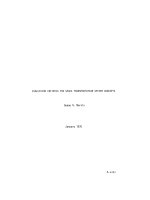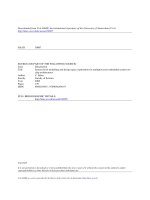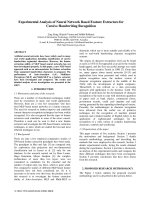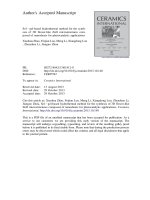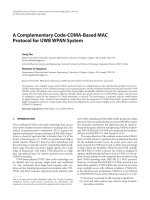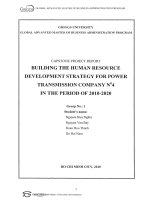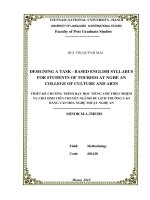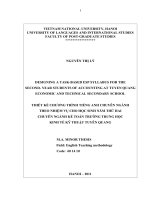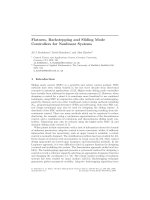Thyristor based FACTS Controllers for Electrical Transmission System
Bạn đang xem bản rút gọn của tài liệu. Xem và tải ngay bản đầy đủ của tài liệu tại đây (5.04 MB, 549 trang )
NEW AGE
FACTS CONTROLLERS
IN POWER TRANSMISSION
AND DISTRIBUTION
~
NEW AGE INTERNATIONAL PUBLISHERS
FACTS CONTROLLERS
IN POWER TRANSMISSION
AND DISTRIBUTION
This page
intentionally left
blank
FACTS CONTROLLERS
IN POWER TRANSMISSION
AND DISTRIBUTION
K. R. Padiyar
Department of Electrical Engineering
Indian Institute of Science
Bangalore-560 012
India
PUBUSHING FOR ONE WORLD
NEW AGE INTERNATIONAL (P) LIMITED, PUBLISHERS
New Delhi· Bangalore • Chennai • Cochin • Guwahati • Hyderabad
lalandhar • Kolkata • Lucknow • Mumbai • Ranchi
Visit us at www.newagepublishers.com
Copyright © 2007, New Age International (P) Ltd., Publishers
Published by New Age International (P) Ltd., Publishers
All rights reserved.
No part of this ebook may be reproduced in any form, by photostat, microfilm,
xerography, or any other means, or incorporated into any information retrieval
system, electronic or mechanical, without the written permission of the publisher.
All inquiries should be emailed to
ISBN (13) : 978-81-224-2541-3
PUBLISHING FOR ONE WORLD
NEW AGE INTERNATIONAL (P) LIMITED, PUBLISHERS
4835/24, Ansari Road, Daryaganj, New Delhi - 110002
Visit us at www.newagepublishers.com
This book is dedicated to
Dr.....1. G. HI.I....I
who pioneered the concepts of
Flexible AC Transmission Systems (FACTS) and Custom Pcwer
This page
intentionally left
blank
Preface
Modern power systems are highly complex and are expected to fulfill the
growing demands of power wherever required, with acceptable quality and
costs. The economic and environmental factors necessitate the location of
generation at places away from load centres. The restructuring of power
utilities has increased the uncertainties in system operation. The regulatory
constraints on the expansion of the transmission network has resulted in
reduction of stability margins and increased the risks of cascading outages
and blackouts. This problem can be effectively tackled by the introduction
of high power electronic controllers for the regulation of power flows and
voltages in AC transmission networks. This allows ’flexible’ operation of
AC transmission systems whereby the changes can be accommodated easily
without stressing the system. Power electronic based systems and other
static equipment that provide controllability of power flow and voltage are
termed as FACTS Controllers.
It is to be noted that power electronic controllers were first introduced in HVDC transmission for not only regulation of power flow in HVDC
links, but also for modulation to improve system stability (both angle and
voltage). The technology of thyristor valves and digital controls was initially extended to the development of Static Var Compensator (SVC) for
load compensation and voltage regulation in long transmission lines. In
1988,Dr.Narain G. Hingorani introduced the concept of Flexible AC Transmission Systems (FACTS) by incorporating power electronic controllers to
enhance power transfer in existing AC transmission lines, improve voltage
regulation and system security without adding new lines. The FACTS controllers can also be used to regulate power flow in critical lines and hence, ease
congestion in electrical networks. FACTS does not refer to any single device,
but a host of controllers such as SVC, Thyristor Controlled Series Capacitor
(TCSC), Static Phase Shifting Transformer (SPST), and newer controllers
based on Voltage Source Converters (VSC)-Static synchronous Compensator (STATCOM), Static Synchronous Series Compensator (SSSC), Unified
Power Flow Controller (UPFC), Interline Power Flow Controller (IPFC) etc.
The advent of FACTS controllers has already made a major impact on the
planning and operation of power delivery systems. The concept of Custom
Power introduced by Dr.Hingorani in 1995 has extended the application of
FACTS controllers for distribution systems with the objective of improving power quality. An understanding of the working of individual FACTS
controllers and issues that affect their operation under various conditions is
essential for both students and engineers (in industry) who are interested in
the subject. This book aims to provide detailed information for students, researchers, and development and application engineers in industry. It contains
viii
FACTS Controllers in Power Transmission and Distribution
comprehensive and up-to-date coverage of the FACTS controllers that have
been proposed and developed both for transmission and distribution. It is
hoped that this book will complement the excellent book on ”Understanding
FACTS-Concepts and Technology of Flexible AC Transmission Systems” by
the pioneers, Dr. Narain G. Hingorani and Dr.Laszlo Gyugyi. The present
book covers many analytical issues that affect the design of FACTS Controllers, which are of interest to academics and application engineers. It can
be used as a text or reference for a course on FACTS Controllers. The author
has been working in the area of HVDC and FACTS Controllers over many
years. He has taught a course on FACTS for graduate students at Indian
Institute of Science and has guided several Masters and PhD students who
have worked on various aspects of different FACTS controllers. He has delivered many lectures in short- term intensive courses attended by teachers
from engineering colleges and engineers from industry. He is the author of a
book on HVDC Power Transmission Systems (published by Wiley Eastern
and John Wiley in 1991), which is widely used. Hence, it was natural to
attempt this book based on the expertise and experience gained.
The book is organized into 14 chapters and 4 appendices. The first
chapter introduces FACTS controllers and their application in transmission
and distribution networks in the context of operational problems of modern
power systems involving transmission congestion, loop flows, system security and power quality issues. The second chapter reviews the modeling and
steady state characteristics of AC transmission lines. It also covers the analysis of how an individual FACTS controller can modify the power flow and
voltage profile in a line.
Chapters 3 to 9 cover the various FACTS controllers -SVC, TCSC
and GCSC, Static PST, STATCOM, SSSC, UPFC, IPFC, CSC, IPC and
other devices such as Fault Current Limiter (FCL), Thyristor Controlled
Braking Resistor (TCBR), NGH Damping and Thyristor Controlled Voltage Limiter (TCVL). In each case, the function of the FACTS device is
explained with the description of power circuit, associated controllers and
operating modes. The modeling of each FACTS Controller is derived from
first principles and simplifications where appropriate are discussed. The
applications and control interactions involving Subsynchronous Resonance
(SSR), electromagnetic interactions and harmonic interactions are also discussed in some detail wherever required.
A major function of a FACTS Controller is power oscillation damping involving low frequency oscillations that threaten system security under
peak power flow conditions. Chapter 10 covers the analysis of this problem
with solutions involving control strategies for voltage and power modulation.
Illustrative examples are included to explain the techniques.
Another important control function is the improvement of transient
stability using bang-bang control technique. This is also termed as discrete
control. The analysis and control strategies for this function are discussed
in detail in chapter 11 with the help of case studies.
Chapter 12 introduces the power quality issues involving voltage fluctuations, flicker, sags and swells, momentary interruptions, unbalance and
harmonics. The measures for power quality are described and introduction
to Custom Power Devices (CPD) is presented. Chapter 13 deals with load
Preface
ix
compensation and application of distribution STATCOM (DSTATCOM) for
fast voltage regulation or reactive power compensation, balancing of source
currents and active filtering. Chapter 14 covers series power quality conditioner involving dynamic voltage restoration and harmonic isolation. The
Unified Power Quality Conditioner (UPQC), which includes both shunt and
series compensators is also described. In all cases considered, the operation
of the individual device is described along with modeling, control algorithms
and simulation of the system to evaluate the performance. The case studies
are presented to illustrate the analysis.
The Appendix A describes the modeling of synchronous machines
for both stability and transient analysis. The mechanical system of rotor
masses and shafts is also modeled. The major Pulse Width Modulation
(PWM) techniques such as Sine PWM and Space Vector modulation are
discussed in Appendix B. The per unit system for a STATCOM is discussed
in Appendix C. The Appendix D lists the abbreviations used.
It is assumed that the reader has an exposure to elementary power
electronics, power systems and basic control theory. Hence, topics on power
semiconductor devices and converters have been deliberately left out. Still,
the book contains more material than what can be covered in a one-semester
course.
Acknowledgements
I would like to acknowledge with gratitude the contributions of several
individuals in the preparation of this book. First and foremost, I wish
to acknowledge the encouragement and help received from Dr.Narain Hingorani who pioneered the concepts of FACTS and Custom Power. Drs.
John Vithayathil (who explained the RANI concept), R.Mohan Mathur,
R.S.Thallam, Rambabu Adapa, Rajiv Varma and Subhashish Bhattacharya
have helped in getting information and literature on FACTS. I acknowledge the research work carried out by my graduate students on FACTS.
Starting with Dr.Rajiv Varma, other PhD students who contributed are:
Drs. Vijayan Immanuel, K. Uma Rao, M.K. Geetha, Anil Kulkarni, Sujatha
Subhash, Parthasarathy Sensarma, S.Krishna, H.V.Saikumar and Nagesh
Prabhu. There are many Masters Students who have worked on FACTS. In
particular, I wish to acknowledge the contributions of Lakshmi Devi, Sreekumar, Jayati, Sriram, Sreekantha, Dhiman, Renuka, Sandeep, Anjali, Rajesh Kumar, Manmayjyoti, Mohanraj, Mahesh Sitaram, Swayam Prakash,
Venkatesh, Dhananjay and Anand Kumar.
I thank Dr. S. Krishna for assisting in proof reading and the preparation of CRC. Thanks are also due to Dr. Nagesh Prabhu and Mr. Anand
Kumar for their help in the preparation of the final manuscript and Mr.
Kiran Kumar for the drawings. Dr. Kalyani Gopal made available the Latex style file used. I thank Mr. Saumya Gupta of New Age International
Publishers for his keen interest and help in publishing this book on time.
This book was catalyzed and supported by the Department of Science and Technology (DST), Government of India under its Utilization of
Scientific Expertise of Retired Scientists (USERS) scheme. The DST has
x
FACTS Controllers in Power Transmission and Distribution
also supported research schemes during the period from 1994 to 2003. The
author also wishes to gratefully acknowledge the financial assistance from
All India Council of Technical Education (AICTE) under the Emeritus Fellowship Scheme during the period (August 1,2003-June 30,2006). Finally,
I am deeply indebted to Indian Institute of Science for permitting me to
pursue academic activities as an Honorary Professor from May 2003.
Last, but not the least, I thank my wife Usha for her patience and
quiet support during the long hours of working on this book.
K.R.Padiyar
Contents
Preface
vii
1 Introduction
1.1
1.2
1
. . . . . . . . . . . . . .
1
. . . . . . . . . . . . . .
1
. . . . . . . . . . . . . .
4
. . . . . . . . . . . . . .
in Distribution Systems
7
16
2 AC Transmission Line and Reactive Power Compensation
19
1.3
1.4
1.5
General . . . . . . . . . . . . . . .
Basics of Power Transmission
Networks . . . . . . . . . . . . . .
Control of Power Flow in AC
Transmission Line . . . . . . . . .
Flexible AC Transmission System
Controllers . . . . . . . . . . . . .
Application of FACTS Controllers
2.1
Analysis of Uncompensated AC Line . . . . . . . . . . . .
19
2.2
Passive Reactive Power Compensation . . . . . . . . . . .
29
2.3
Compensation by a Series Capacitor Connected at the Midpoint of the Line . . . . . . . . . . . . . . . . . . . . . . .
32
2.4
Shunt Compensation Connected at
the Midpoint of the Line . . . . . . . . . . . . . . . . . . .
34
2.5
Comparison between Series and Shunt Capacitor
. . . . .
36
2.6
Compensation by STATCOM and
SSSC . . . . . . . . . . . . . . . . . . . . . . . . . . . . . .
Some Representative Examples . . . . . . . . . . . . . . .
38
42
2.7
3 Static Var Compensator
51
3.1
Analysis of SVC . . . . . . . . . . . . . . . . . . . . . . . .
51
3.2
Configuration of SVC . . . . . . . . . . . . . . . . . . . . .
58
3.3
3.4
68
3.5
SVC Controller . . . . .
Voltage Regulator Design
Issues . . . . . . . . . . .
Harmonics and Filtering
. . . . . . . . . . . . . . . . . . .
– Some
. . . . . . . . . . . . . . . . . . .
. . . . . . . . . . . . . . . . . . .
75
83
3.6
Protection Aspects . . . . . . . . . . . . . . . . . . . . . .
91
FACTS Controllers in Power Transmission and Distribution
3.7
Modelling of SVC . .
96
3.8
Applications of SVC
99
4 Thyristor and GTO Controlled Series Capacitor
105
4.1
4.2
Introduction . . . . . . . . . . . . . . . . . . . . .
Basic Concepts of Controlled Series Compensation
105
106
4.3
Operation of TCSC
110
4.4
Analysis of TCSC .
112
4.5
4.6
Control of TCSC
Modelling of TCSC for Stability
Studies . . . . . . . . . . . . . .
GTO Thyristor Controlled Series
Capacitor (GCSC) . . . . . . . .
118
4.7
4.8
4.9
Mitigation of Subsynchronous
Resonance with TCSC and GCSC .
Applications of TCSC. . . . . . .
5 Static Phase Shifting Transformer
122
125
128
150
157
5.1
5.2
General..........
Basic Principle of a PST
157
157
5.3
Configurations of SPST .
161
5.4
Improvement of Transient Stability
Using SPST . . . . . . . . . . . . .
166
Damping of Low Frequency Power
Oscillations . . . . .
Applications of SPST . . . . . . . .
168
170
5.5
5.6
6 Static Synchronous Compensator (STATCOM)
173
6.1
6.2
Introduction . . . . . . . . . . . . . .
Principle of Operation of STATCOM
173
174
6.3
6.4
A Simplified Analysis of a Three
Phase Six Pulse STATCOM . . . . .
Analysis of a Six Pulse VSC Using Switching Functions.
177
184
6.5
Multi-pulse Converters . . . .
188
6.6
Control of Type 2 Converters
192
6.7
Control of Type 1 Converter.
197
6.8
Multilevel Voltage Source Converters
200
6.9
6.10
Harmonic Transfer and Resonance in VSC
Applications of STATCOM . . . . . . . . .
209
213
Contents
7 Static Synchronous Series Compensator
217
7.1
7.2
Introduction......................
Operation of SSSC and the Control of Power Flow
217
217
7.3
Modelling and Control of SSSC
225
7.4
SSSC with an Energy Source .
229
7.5
Analysis of SSR with a SSSC
237
7.6
Applications of SSSC . . . . .
240
8 Unif]ed Power Flow Controller and other Multi-Converter
DeVIces
243
8.1
8.2
Introduction......
Operation of a UPFC .
243
246
8.3
8.4
8.5
8.6
Control of UPFC . . .
Protection of UPFC . .
Interline Power Flow Controller
Convertible Static Compensator
257
262
263
265
8.7
Modelling of UPFC, IPFC and other Multi-Converter FACTS
266
8.8
8.9
SSR Characteristics of UPFC
Applications of UPFC . . . . . . . . . . . . . . . . . . . .
269
269
9 Interphase Power Controller and other FACTS Devices
273
9.1
Interphase Power Controller (IPC)
273
9.2
NGH SSR Damping Scheme .
286
9.3
Thyristor Controlled Braking
Resistor (TCBR) . . . . . . .
291
9.4
Fault Current Limiter (FCL) .
293
9.5
Thyristor Controlled Voltage Limiter (TCVL)
296
10 Power Oscillation Damping
10.1
10.2
10.3
Introduction . . . . . . .
Basic Issues in the Damping of Low
Frequency Oscillations in Large
Power Systems. . . . . . . . . . . .
301
301
302
System Modelling for Small Signal
Stability . . . . . . . . . . . . .
305
10.4
Design of Damping Controllers.
316
10.5
Modal 'fransformation of Swing
Equations . . . . . . . . . . . .
322
FACTS Controllers in Power Transmission and Distribution
10.6
10.7
10.8
Damping of Power Oscillations
Using Series FACTS Controllers
325
Damping of Power Oscillations
Using Shunt FACTS Controllers
334
A Case Study of Damping Controllers in UPFC
340
11 Improvement of Transient Stability
349
11.1
11.2
Introduction . . . . . . . . . . . . . . . . . . .
Transient Stability of a Two Machine System
349
350
11.3
Extension to Multimachine Power
Systems . . . . . . . . . . . . . . . . . . . . .
352
11.4
Potential Energy Function for SVC, SSSC and UPFC
361
11.5
A New Control Algorithm for
Improving Transient Stability
and Damping of Oscillations .
366
Case Studies of Discrete Control for
Stability Improvement . . . . . . .
374
11.6
12 Power Quality and Introduction to Custom Power Devices
383
12.1
12.2
12.3
12.4
12.5
12.6
General . . . . .
Electromagnetic Phenomena and
Power Quality . . . . . . . . .
383
Custom Power Devices . . . . . .
Definitions of Reactive Power ..
Reactive Power Compensation in
Single Phase Circuits . . . . . . .
394
403
Reactive Power Compensation in Three Phase Circuits
420
13 Load Compensation and Distribution STATCOM
384
412
433
13.1
13.2
Introduction . . . . . . . . . . . .
Three Phase Three Wire Systems
433
434
13.3
Three Phase Four Wire Systems.
443
13.4
A Case Study . . . . . . . . . . .
448
13.5
Synchronous Reference Frame Based
Extraction of Reference Currents .
Instantaneous Active and Reactive
Current Based Extraction of
Reference Currents . . . . . . .
Application of DSTATCOM for
Reactive Power Compensation
and Voltage Regulation . . . . .
13.6
13.7
450
453
460
Contents
13.8
13.9
Current Control Techniques for PWM
Converters . . . . . . . . .
Application of Composite
Compensation . . . . . . .
461
464
14 Dynamic Voltage Restorer and Unified Power Quality Conditioner
467
14.1
14.2
Introduction . . . . . . . . . .
Dynamic Voltage Restoration
467
468
14.3
Series Active Filtering
....
473
14.4
A Case Study on DVR . . . .
477
14.5
Unified Power Quality Conditioner
484
14.6
A Case Study on UPQC . . . . . .
487
A Modelling of Synchronous Generator
495
A.1
Synchronous Machine Model . .
495
A.2
Modelling of Turbine Generator
Mechanical Systems . . . . . . .
501
Relationship between Park and Kron Transformation
504
A.3
B Pulse W;dth Modulation for Voltage Source Converters
507
B.1
B.2
Introduction.: . . . . . . . . . . . . .
Selective Harmonic Elimination (SHE)
507
509
B.3
B.4
Sinusoidal PWM . . . . . . . . .
Space Vector Modulation (SVM)
511
515
C Per Unit System for STATCOM
523
D Abbreviations
52'7
Index
529
This page
intentionally left
blank
Chapter 1
Introduction
1.1
General
Modern power systems are designed to operate efficiently to supply power
on demand to various load centres with high reliability. The generating
stations are often located at distant locations for economic, environmental
and safety reasons. For example, it may be cheaper to locate a thermal power
station at pithead instead of transporting coal to load centres. Hydropower
is generally available in remote areas. A nuclear plant may be located at a
place away from urban areas. Thus, a grid of transmission lines operating at
high or extra high voltages is required to transmit power from the generating
stations to the load centres.
In addition to transmission lines that carry power from the sources
to loads, modern power systems are also highly interconnected for economic
reasons. The interconnected systems benefit by (a) exploiting load diversity
(b) sharing of generation reserves and (c) economy gained from the use of
large efficient units without sacrificing reliability. However, there is also
a downside to ac system interconnection – the security can be adversely
affected as the disturbances initiated in a particular area can spread and
propagate over the entire system resulting in major blackouts caused by
cascading outages.
1.2
Basics of Power Transmission
Networks
A large majority of power transmission lines are AC lines operating at different voltages (10 kV to 800 kV). The distribution networks generally operate below 100 kV while the bulk power is transmitted at higher voltages.
The lines operating at different voltages are connected through transformers
which operate at high efficiency. Traditionally, AC lines have no provision
for the control of power flow. The mechanically operated circuit breakers
(CB) are meant for protection against faults (caused by flashovers due to
overvoltages on the lines or reduced clearances to ground). A CB is rated for
a limited number of open and close operations at a time and cannot be used
2
FACTS Controllers in Power Transmission and Distribution
for power flow control. (unlike a high power electronic switch such as thyristor, GTO, IGBT, IGCT, etc.). Fortunately, ac lines have inherent power
flow control as the power flow is determined by the power at the sending
end or receiving end. For example, consider a trasmission line connecting a
generating station to a load centre in Fig.1.1(a). Assuming the line to be
lossless and ignoring the line charging, the power flow (P ) is given by
P =
V1 V2
sin(θ1 − θ2 )
X
(1.1)
where X is the series line reactance. Assuming V1 and V2 to be held constants
(through voltage regulators at the two ends), the power injected by the power
station determines the flow of power in the line. The difference in the bus
angles is automatically adjusted to enable P = PG (Note that usually there
could be more than one line transmitting power from a generating station
to a load centre). If one or more lines trip, the output of the power station
may have to be reduced by tripping generators, so as to avoid overloading
the remaining lines in operation.
V1 θ 1
G
V2 θ 2
jX
P=P
G
(a) A line transmitting power from a generating station
V1 θ 1
V2 θ 2
jX
Load
P=P
L
(b) A line supplying power to a load
Figure 1.1: A transmission line carrying power
Fig. 1.1(b) shows another situation where a line supplies power to a
load located at bus (2). Here also the eq. (1.1) applies but the power flow in
the line is determined by the load supplied. The essential difference between
the two situations is that in Fig. 1.1(a), the load centre is modelled as an
infinite bus which can absorb (theoretically) any amount of power supplied
to it from the generating station. This model of the load centre assumes that
the generation available at the load centre is much higher than the power
supplied from the remote power station (obviously, the total load supplied
at the load centre is equal to the net generation available at that bus).
1. Introduction
3
The reliability of the power supply at a load bus can be improved by
arranging two (or more) sources of power as shown in Fig. 1.2. Here, P 1 is
the output of G1 while P2 is the output of G2 (Note that we are neglecting
losses as before). However, the tripping of any one line will reduce the
availability of power at the load bus. This problem can be overcome by
providing a line (shown dotted in Fig. 1.2) to interconnect the two power
stations. Note that this results in the creation of a mesh in the transmission
network. This improves the system reliability, as tripping of any one line does
not result in curtailment of the load. However, in steady state, P1 can be
higher or lower than PG1 (the output of G1). The actual power flows in the
3 lines forming a mesh are determined by Kirchhoff’s Voltage Law (KVL).
In general, the addition of an (interconnecting) line can result in increase
of power flow in a line (while decreasing the power flow in some other line).
This is an interesting feature of AC transmission lines and not usually well
understood (in the context of restructuring). In general, it can be stated that
in an uncontrolled AC transmission network with loops (to improve system
reliability), the power flows in individual lines are determined by KVL and
do not follow the requirements of the contracts (between energy producers
and customers). In other words, it is almost impossible to ensure that the
power flow between two nodes follows a predetermined path. This is only
feasible in radial networks (with no loops), but the reliability is adversely
affected as even a single outage can result in load curtailment. Consider
two power systems, each with a single power station meeting its own local
load, interconnected by a tie line as shown in Fig. 1.3(a). In this case, the
power flow in the tie line (P ) in steady state is determined by the mismatch
between the generation and load in the individual areas. Under dynamic
conditions, this power flow is determined from the equivalent circuit shown
in Fig. 1.3(b). If the capacity of the tie is small compared to the size
(generation) of the two areas, the angles δ1 and δ2 are not affected much by
the tie line power flow. Thus, power flow in AC tie is generally uncontrolled
and it becomes essential to trip the tie during a disturbance, either to protect
the tie line or preserve system security.
In comparison with a AC transmission line, the power flow in a
HVDC line in controlled and regulated. However, HVDC converter stations
are expensive and HVDC option is used primarily for (a) long distance bulk
power transmission (b) interconnection of asynchronous systems and (c) underwater (submarine) transmission. The application of HVDC transmission
(using thyristor converters) is also constrained by the problem of commutation failures affecting operation of multiterminal or multi-feed HVDC systems. This implies that HVDC links are primarily used for point-to-point
transmission of power and asynchronous interconnection (using Back to Back
(BTB) links).
4
FACTS Controllers in Power Transmission and Distribution
V1 θ 1
P1
G1
PL
V2 θ 2
G2
P2
Figure 1.2: Two generating stations supplying a load
V1 θ1
V2 θ 2
P
(a)Single line diagram
E1 δ1
V1 θ1
Z1
E2 δ 2
V2 θ 2
jX
Thevenin equivalent of area 1
Z2
Thevenin equivalent of area 2
(b)Equivalent circuit
Figure 1.3: Two areas connected by a tie line
1.3
Control of Power Flow in AC
Transmission Line
We may like to control the power flow in a AC transmission line to (a)
enhance power transfer capacity and or (b) to change power flow under
dynamic conditions (subjected to disturbances such as sudden increase in
load, line trip or generator outage) to ensure system stability and security.
The stability can be affected by growing low frequency, power oscillations
(due to generator rotor swings), loss of synchronism and voltage collapse
caused by major disturbances.
1. Introduction
5
From eq. (1.1), we have the maximum power (Pmax ) transmitted
over a line as
V1 V2
sin δmax
(1.2)
Pmax =
X
where δmax (30◦ –40◦ ) is selected depending on the stability margins and the
stiffness of the terminal buses to which the line is connected. For line lengths
exceeding a limit, Pmax is less than the thermal limit on the power transfer
determined by the current carrying capacity of the conductors (Note this is
also a function of the ambient temperature). As the line length increases, X
increases in a linear fashion and Pmax reduces as shown in Fig. 1.4.
Thermal limit
Pmax
Stability limit
Line length
Figure 1.4: Power transfer capacity as a function of line length
The series compensation using series connected capacitors increases
Pmax as the compensated value of the series reactance (Xc ) is given by
Xc = X(1 − kse )
(1.3)
where kse is the degree of series compensation. The maximum value of kse
that can be used depends on several factors including the resistance of the
conductors. Typically kse does not exceed 0.7.
Fixed series capacitors have been used since a long time for increasing power transfer in long lines. They are also most economical solutions for
this purpose. However, the control of series compensation using thyristor
6
FACTS Controllers in Power Transmission and Distribution
switches has been introduced only 10–15 years ago for fast power flow control. The use of Thyristor Controlled Reactors (TCR) in parallel with fixed
capacitors for the control of Xc , also helps in overcoming a major problem of
Subsynchronous Resonance (SSR) that causes instability of torsional modes
when series compensated lines are used to transmit power from turbogenerators in steam power stations.
In tie lines of short lengths, the power flow can be controlled by
introducing Phase Shifting Transformer (PST) which has a complex turns
ratio with magnitude of unity. The power flow in a lossless transmission line
with an ideal PST (see Fig. 1.5) is given by
P =
V1 V2
sin(θ ± φ)
X
(1.4)
where θ = θ1 − θ2 .
V1
θ1
V2 θ2
jX
1: e j φ
Figure 1.5: A lossless line with an ideal PST
Again, manually controlled PST is not fast enough under dynamic
conditions. Thyristor switches can ensure fast control over discrete (or continuous) values of φ, depending on the configuration of PST used. Pmax
can also be increased by controlling (regulating) the receiving end voltage
of the AC line. When a generator supplies a unity power factor load (see
Fig. 1.1(b)), the maximum power occurs when the load resistance is equal
to the line reactance. It is to be noted that V2 varies with the load and can
be expressed as
V2 = V1 cos(θ1 − θ2 )
(1.5)
Substituting (1.5) in (1.1) gives
P =
V12 sin[2(θ1 − θ2 )]
2X
(1.6)
By providing dynamic reactive power support at bus (2) as shown in
Fig. (1.6), it is possible to regulate the bus voltage magnitude. The reactive
1. Introduction
7
V1 θ1
V2 θ2
jX
Load at unity
power factor
Qc
Figure 1.6: Transmission line compensated by controllable reactive power
source at receiving end
power (QC ) that has to be injected is given by
QC =
V22 − V1 V2 cos(θ1 − θ2 )
X
(1.7)
Comparing eq. (1.6) with (1.1), it can be seen that the maximum
power transfer can be doubled just by providing dynamic reactive power
support at the receiving end of the transmission line. This is in addition
to the voltage support at the sending end. It is to be noted that while
steady state voltage support can be provided by mechanically switched capacitors, the dynamic voltage support requires synchronous condenser or a
power electronic controller such as Static Var Compensator (SVC) or STATic
synchronous COMpensator (STATCOM).
1.4
1.4.1
Flexible AC Transmission System
Controllers
General Description
The large interconnected transmission networks (made up of predominantly
overhead transmission lines) are susceptible to faults caused by lightning
discharges and decrease in insulation clearances by undergrowth. The power
flow in a transmission line is determined by Kirchhoff’s laws for a specified
power injections (both active and reactive) at various nodes. While the
loads in a power system vary by the time of the day in general, they are also
subject to variations caused by the weather (ambient temperature) and other
unpredictable factors. The generation pattern in a deregulated environment
also tends to be variable (and hence less predictable). Thus, the power flow
in a transmission line can vary even under normal, steady state conditions.
The occurrence of a contingency (due to the tripping of a line, generator)
can result in a sudden increase/decrease in the power flow. This can result
in overloading of some lines and consequent threat to system security.
8
FACTS Controllers in Power Transmission and Distribution
A major disturbance can also result in the swinging of generator
rotors which contribute to power swings in transmission lines. It is possible
that the system is subjected to transient instability and cascading outages
as individual components (lines and generators) trip due to the action of
protective relays. If the system is operating close to the boundary of the
small signal stability region, even a small disturbance can lead to large power
swings and blackouts.
The increase in the loading of the transmission lines sometimes can
lead to voltage collapse due to the shortage of reactive power delivered at
the load centres. This is due to the increased consumption of the reactive
power in the transmission network and the characteristics of the load (such
as induction motors supplying constant torque).
The factors mentioned in the previous paragraphs point to the problems faced in maintaining economic and secure operation of large interconnected systems. The problems are eased if sufficient margins (in power transfer) can be maintained. This is not feasible due to the difficulties in the expansion of the transmission network caused by economic and environmental
reasons. The required safe operating margin can be substantially reduced
by the introduction of fast dynamic control over reactive and active power
by high power electronic controllers. This can make the AC transmission
network ‘flexible’ to adapt to the changing conditions caused by contingencies and load variations. Flexible AC Transmission System (FACTS) is
defined as ‘Alternating current transmission systems incorporating power
electronic-based and other static controllers to enhance controllability and
increase power transfer capability’ [1,2]. The FACTS controller is defined as
‘a power electronic based system and other static equipment that provide
control of one or more AC transmission system parameters’.
The FACTS controllers can be classified as
1. Shunt connected controllers
2. Series connected controllers
3. Combined series-series controllers
4. Combined shunt-series controllers
Depending on the power electronic devices used in the control, the
FACTS controllers can be classified as
(A) Variable impedance type
(B) Voltage Source Converter (VSC) – based.
The variable impedance type controllers include:

